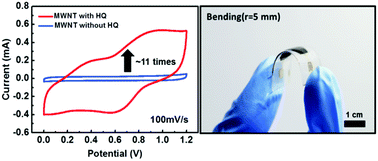High performance flexible double-sided micro-supercapacitors with an organic gel electrolyte containing a redox-active additive†
Abstract
In this study, we report the fabrication of a high performance flexible micro-supercapacitor (MSC) with an organic gel electrolyte containing a redox-active additive, referred to as poly(methyl methacrylate)-propylene carbonate-lithium perchlorate-hydroquinone (PMMA-PC-LiClO4-HQ). Hexagonal MSCs fabricated on thin polyethylene terephthalate (PET) films had interdigitated electrodes made of spray-coated multi-walled carbon nanotubes (MWNTs) on Au. The addition of HQ as a redox-active additive enhanced not only the specific capacitance but also the energy density of the MSCs dramatically, which is approximately 35 times higher than that of MSCs without the HQ additive. In addition, both areal capacitance and areal energy density could be doubled by fabrication of double-sided MSCs, where two MSCs are connected in parallel. The double-sided MSCs exhibited stable electrochemical performance during repeated deformation by bending. By dry-transferring the double-sided MSCs based on PMMA-PC-LiClO4-HQ on a deformable polymer substrate, we fabricated a stretchable MSC array, which also retained its electrochemical performance during a uniaxial strain of 40%. Furthermore, a wearable energy storage bracelet made of such an MSC array could operate a μ-LED on the wrist.



 Please wait while we load your content...
Please wait while we load your content...